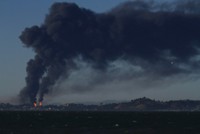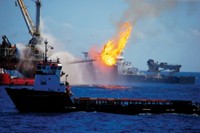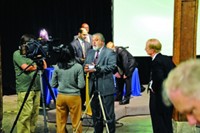Advertisement
Grab your lab coat. Let's get started
Welcome!
Welcome!
Create an account below to get 6 C&EN articles per month, receive newsletters and more - all free.
It seems this is your first time logging in online. Please enter the following information to continue.
As an ACS member you automatically get access to this site. All we need is few more details to create your reading experience.
Not you? Sign in with a different account.
Not you? Sign in with a different account.
ERROR 1
ERROR 1
ERROR 2
ERROR 2
ERROR 2
ERROR 2
ERROR 2
Password and Confirm password must match.
If you have an ACS member number, please enter it here so we can link this account to your membership. (optional)
ERROR 2
ACS values your privacy. By submitting your information, you are gaining access to C&EN and subscribing to our weekly newsletter. We use the information you provide to make your reading experience better, and we will never sell your data to third party members.
Safety
CSB Seeks Small Budget Increase
Chemical safety board requests $11.4 million for 2013 and hopes to close six investigations this year
by Jeff Johnson
March 12, 2012
| A version of this story appeared in
Volume 90, Issue 11
A “spartan” budget was how an official with the Chemical Safety & Hazard Investigation Board (CSB) described the agency’s budget request for 2013. The independent board is seeking $11.4 million to continue investigating chemically related industrial accidents in fiscal 2013. The level is only 2.4% more than its 2012 appropriation of $11.1 million.
The proposed amount will continue to make it hard for the board to keep up with its charge, potentially ensuring that important chemically related accidents will not be investigated. In fact, the board’s request is $1.4 million, or 10.9%, less than the board sought last year and did not obtain. However, CSB notes that its 2013 request complies with “federal deficit reduction plans.”
“Our goal is to hire more investigators,” stresses Daniel M. Horowitz, CSB’s managing director. About two-thirds of the board’s budget goes toward salaries and benefits for some 49 staff members, half of whom are inspectors.
Budget documents show the board’s appropriation has been on a minuscule rise over its 15-year history. In the past half-dozen years, CSB’s funding has been basically flat, according to budget documents released on Feb. 13. The request, CSB says, will allow it to close a “significant backlog of open major accident investigations,” along with filling vacant investigator positions.
CSB is charged with tracking, monitoring, and investigating “high-consequence chemical incidents” that result in deaths, hospitalizations, property damage in excess of $500,000, and large evacuations. CSB has no regulatory authority; instead it is charged with determining the root cause of chemical accidents and providing advice to companies, regulators, and others in how practices and equipment should be changed to better protect workers and the public.
CSB staff recorded 282 incidents that met the board’s threshold for investigation in 2011, and 162 similar accidents occurred in 2010. However, the board was able to investigate just a handful of those accidents: 2.8% of them in 2011 and 5.6% in 2010.
The low investigation rate is problematic. The most recent data from the Bureau of Labor Statistics, cited by CSB, show that workplace deaths from exposure to harmful substances and environments, fires, and explosions have not decreased much in the past several years. However, serious resource constraints have prevented CSB from investigating more than a few of the most serious incidents each year, according to budget documents.
In 2011, CSB began only eight investigations and completed five; in 2010, it started nine and completed four. Fourteen investigations are ongoing, and two of them are of accidents that occurred in 2008.
For comparison, consider the National Transportation Safety Board (NTSB), which has a similar investigative responsibility but focuses on transportation-related accidents. Its annual budget is about $102 million, and it has more than 350 employees. In 2010, it launched six major investigations and some 200 smaller ones. According to NTSB documents, around 900 accidents occurred that NTSB could have investigated but did not because of insufficient resources. NTSB did not provide an official to speak on the record about its activities and instead provided documents.
According to Horowitz, CSB plans to complete six investigations during 2012. One of the six was closed last month: an investigation of a series of dust explosions that killed five workers at Hoeganaes’ facility in Gallatin, Tenn., over a six-month period last year (C&EN, Jan. 16, page 28).
The other five are investigations of a fire and explosion at Carbide Industries in Louisville that killed two workers in 2011; a dust explosion at AL Solutions in West Virginia that killed three workers in 2010; an explosion and fire that killed one worker at DuPont’s Buffalo plant in 2010; an explosion at an NDK America plant in Illinois that injured several people and killed a member of the public in 2009; and the 2009 Caribbean Petroleum Refining fire and explosion in Puerto Rico that damaged homes and buildings more than a mile from the facility.
During 2013, Horowitz continues, the board intends to complete two complex and thorny investigations. One is of a refinery accident that killed seven workers in 2010 at the Tesoro Refinery in Anacortes, Wash. The second is its investigation of the BP Deepwater Horizon oil spill in the Gulf of Mexico that killed 11 and led to the biggest oil spill in U.S. history.
CSB began the Gulf investigation in 2010 in compliance with a congressional request. The board asked for and expected Congress to provide additional funding for the investigation, but Congress did not. By the end of 2011, CSB had spent $2.3 million on the investigation, nearly a quarter of its annual budget, according to budget documents. The probe also drew investigators and staff from other CSB investigations.
The funding shortfall, CSB says, contributed to its backlog of 14 investigations and has made it reluctant to begin new investigations. However, CSB has been criticized by Congress and others for not initiating more investigations. As a result, CSB has turned to other ways of advocating for chemical safety, such as safety videos based on its investigations; brief safety bulletins; and recommendations to state legislatures and governments, federal safety bodies, and professional societies. Last year, it completed five videos, and in recent years it has produced a total of 26 safety videos related to its investigations.
Next year, the board plans to begin what it calls a “most wanted list,” similar to one developed by NTSB. CSB will use the list to spotlight conditions in labs and manufacturing plants that have had a history of causing chemically related disasters. The list could focus on explosive dust, worker fatigue, and university lab practices that have led to accidents, CSB says.
Since CSB’s investigation of a chemistry department accident at Texas Tech University last year, the frequency of U.S. academic laboratory incidents has become an area of significant concern for CSB (C&EN, Feb. 1, 2010, page 25). Since 2001, the board has gathered preliminary information on 120 different university laboratory incidents that resulted in 87 evacuations, 96 injuries, and three deaths.
When releasing its report on the Texas Tech accident last September, the board conducted its first webinar on lab safety, which drew 400 participants. The report broke new ground by calling for the American Chemical Society to develop nationwide guidance on how to assess and control laboratory risks. ACS, which publishes C&EN, has agreed with the recommendation and is working on the new safety tools.





Join the conversation
Contact the reporter
Submit a Letter to the Editor for publication
Engage with us on Twitter